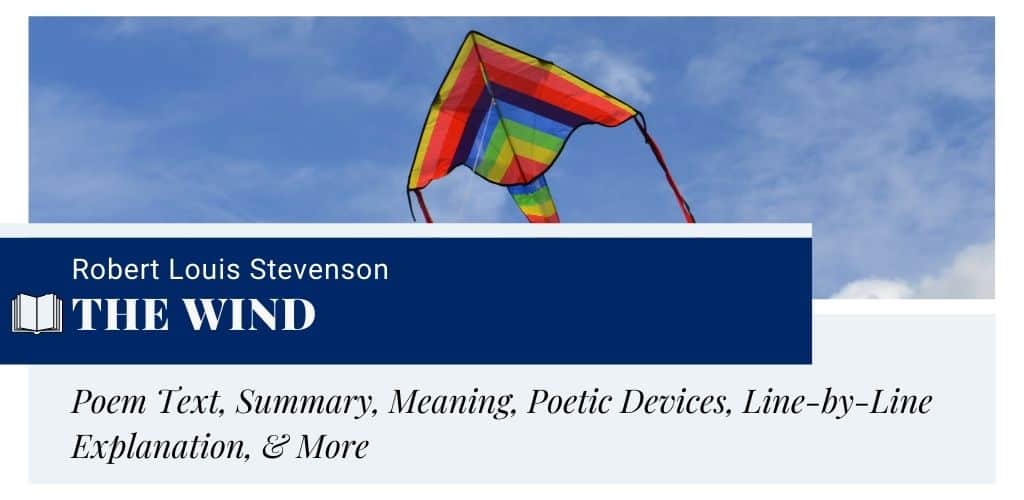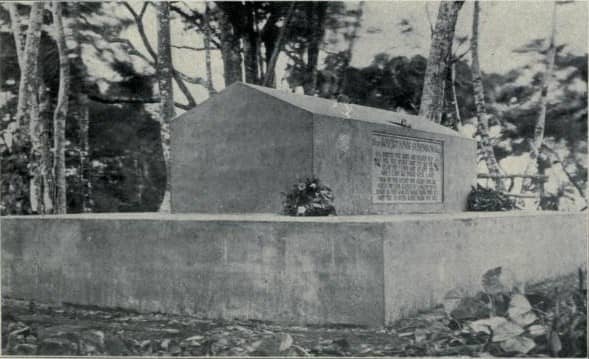The Wind by Robert Louis Stevenson
“The Wind” is all about a little child’s thoughtful description of the mighty and omnipresent wind. Robert Louis Stevenson appreciates the way it keeps going everywhere boundless. While going from one place to the other, it makes several sounds to portray its presence. These sounds appeal to the senses of the child in Stevenson’s poem. The lyrical quality along with the musicality of the poem makes this poem an interesting read. It not only appeals to children but also people of all ages who still have a childlike mind. Stevenson shows nature’s innocence and a child’s proximity with this quality through this poem that first appeared in A Child’s Garden of Verses.
- Read the full text of “The Wind” below:
The Wind
by Robert Louis Stevenson
I saw you toss the kites on high
And blow the birds about the sky;
And all around I heard you pass,
Like ladies' skirts across the grass—
O wind, a-blowing all day long,
O wind, that sings so loud a song!
I saw the different things you did,
But always you yourself you hid.
I felt you push, I heard you call,
I could not see yourself at all—
O wind, a-blowing all day long,
O wind, that sings so loud a song!
O you that are so strong and cold,
O blower, are you young or old?
Are you a beast of field and tree,
Or just a stronger child than me?
O wind, a-blowing all day long,
O wind, that sings so loud a song!
- from A Child's Garden of Verses (1885)

Summary
In the first stanza of “The Wind”, the child-speaker describes what the wind does. It tosses the kites and blows the birds in the sky. The kid can hear it passing around like ladies’ skirts across the grass. The last two lines that are repeated throughout the poem describe how the wind blows all day long by singing a loud song.
The child saw the things it did invisibly. But, he can feel its push and can hear its call. However, he cannot see it at all. Furthermore, he asks the strong and cold wind about its age. It seems to him as a beast of nature or just a stronger child than him. On this note, Stevenson concludes the poem.
Meaning
This poem centers on a child’s impassioned address to the wind. It represents Stevenson’s poetic self. Through this poem, his speaker describes what are the things the wind does. He refers to the kite and the birds in order to portray how the mighty wind helps them to float in the sky. The main idea of this poem concerns the invisibility of the wind and its effects that are visible to the child. As he cannot see the wind, it makes his mind more confused regarding its very existence.
He goes on thinking about its nature. He makes a comparison between him and the wind to portray how powerful it is. Besides, the idea of the wind’s loud song is reiterated throughout the piece in order to portray the musicality of the wind.
Form, Rhyme Scheme, & Meter
Form
Stevenson’s “The Wind” consists of three stanzas. Each stanza has six lines. The first four lines are written in the form of a quatrain consisting of two rhyming couplets. While the last two lines that are used as a refrain, are indented to the right. Besides, this poem is written in the form of an interrogation of a child to the wind. Stevenson uses the child’s point of view in this piece. Due to the presence of a first-person speaker alongside the rhythm and musicality, it is a beautiful lyric.
Rhyme Scheme
The rhyme scheme of this poem is AABBCC. It means the first two lines form a rhyming couplet. The same applies to the next two lines. It goes on like this. For example, in the first two lines, the words “high” and “sky” rhyme. Then, in the next lines, “pass” and “grass”, and “long” and “song” rhyme.
Meter
Stevenson composed this piece in iambic tetrameter. It means there are four iambic beats (unstressed-stressed) per line. How does it work? For example, in the first line, there are eight syllables (“I saw you toss the kites on high”). If we group the syllable in units of two syllables, there will be four units. Then, one has to stress on the second syllable of each unit, also known as a metrical foot. Let’s have a look at the scansion of the first stanza in order to understand the overall metrical scheme.
I saw/ you toss/ the kites/ on high
And blow/ the birds/ a-bout/ the sky;
And all/ a-round/ I heard/ you pass,
Like la/-dies’ skirts/ a-cross/ the grass—
O wind,/ a-blow/-ing all/ day long,
O wind,/ that sings/ so loud/ a song!
As we can see, while reading the beat sounds daa-dum.
Poetic Devices & Figurative Language
In “The Wind”, Stevenson uses a number of devices that are mentioned below.
- Personification: In this poem, Stevenson personifies the wind and invests it with the ideas of tossing the kites, blowing the birds, singing a loud song, etc.
- Anaphora: Firstly, it occurs in the second and third lines. These lines begin with the word “And”. It also occurs in the last two lines of each stanza.
- Refrain: The last two lines are repeated at the end of each stanza. It is used as a refrain.
- Alliteration: It occurs in “blow the birds”, “sings so”, “you yourself you”, “so strong”, etc.
- Simile: Stevenson uses this device in “Like ladies’ skirts across the grass” and “Or just a stronger child than me?”
- Metaphor: It occurs in “a beast of field and tree” and “a stronger child”. Here, the speaker compares the wind to a beast and a child respectively.
- Apostrophe: In the refrain, this device is used. It also occurs in the first two lines of the last stanza. In these lines, the speaker evokes the spirit of the wind.
The Wind Explained: Line-by-Line Analysis & Explanation
Lines 1-6
I saw you toss the kites on high
And blow the birds about the sky;
And all around I heard you pass,
Like ladies’ skirts across the grass—
O wind, a-blowing all day long,
O wind, that sings so loud a song!
R.L. Stevenson’s poem “The Wind” presents a first-person speaker in the very beginning. This poem is written from a child speaker’s perspective who describes the wind using vivid imagery. Firstly, he presents kinesthetic imagery of the wind. He describes how it tosses the kites flying high in the sky. Then he depicts how the birds are blown about the sky. It seems as if the wind, as a mighty and generous creature, helps them to fly.
The speaker can hear it pass all around. Stevenson associates the sound of wind by using auditory imagery. He describes how the wind blows by comparing it with frolicking ladies’ skirts. The way they run across the grass playfully is compared with the passing of the wind. In this way, the poet personifies the wind as a feminine force of nature.
In the last two lines that are repeated in the next two stanzas, Stevenson’s speaker addresses the wind to hear his call. He describes the wind as blowing all day long restlessly. While blowing it sings so loud a song that the child can listen even when he is at home. Here, the musicality in the wind’s sound is portrayed.
Lines 7-12
I saw the different things you did,
But always you yourself you hid.
I felt you push, I heard you call,
I could not see yourself at all—
O wind, a-blowing all day long,
O wind, that sings so loud a song!
In the following stanza, the speaker describes how the wind does different things. It is not limited to the things described in the first stanza. Sometimes it becomes as angry as it topples everything that comes across its past. At times, it becomes so soothing that it can inspire one’s weary spirit. The speaker says though it does a number of things, it keeps itself hidden. None can visualize its existence. It can only be felt through one’s tactile senses.
The speaker can feel how it pushes him while he is in the field. He can hear the way he calls his wild spirit. In the next line, he reiterates the idea of the invisibility of the wind. It seems he is a bit sad for not being able to see it.
The last two lines are repeated again in this stanza for the sake of emphasizing the everlasting nature of the wind as well as its beautiful song.
Lines 13-18
O you that are so strong and cold,
O blower, are you young or old?
Are you a beast of field and tree,
Or just a stronger child than me?
O wind, a-blowing all day long,
O wind, that sings so loud a song!
The last stanza begins with the use of an apostrophe. Stevenson also uses anaphora in the first two lines. His speaker addresses the wind as a strong and cold figure. The first idea is connected with its might. While the second idea of “cold” resonates with the soothing effect of the wind.
In the next line, he asks a rhetorical question to the wind. He asks whether it is young or old. This question makes it clear that the wind is not any of them. It is an everlasting force of nature that is ageless and timeless.
In the following line, it is compared to a beast of fields and trees. Here, Stevenson uses the metaphor of a beast in order to portray how the wind blows over fields and about the trees. Its swiftness and agility are compared to that of a wild creature that cannot be tamed.
It also seems to the speaker that the wind is a child like him. But, it is stronger than him. There is an important thing to note regarding the metaphor. The comparison between wind and a child reveals the resemblance between a child’s spirit and that of nature. They are both wild, playful, and energetic.
The repetition of the last two lines creates musicality within the text that resonates with the loud song of the wind.
Historical Context
Robert Louis Stevenson’s influential 19th-century children’s book, A Child’s Garden of Verses, is the source of the poem “The Wind.” This collection contains several poems that describe how a child thinks and appreciates nature. It was first published in 1885. A children’s book of 1880 influenced Stevenson to write this collection. He dedicated this book to his childhood nurse Alison Cunningham. “The Wind” was arranged along with the poems “Rain”, “Singing”, “Marching Song”, and “At the Sea-side” as a six-song cycle by the Lithuanian composer Giedrius Alkauskas.
Questions & Answers
The main idea of Stevenson’s poem concerns the things the wind does and a child’s inability to see it. He goes on to describe its might. At last, he asks about its nature. Besides, the idea of nature’s permanence and musicality is reiterated throughout the poem.
In these lines, the wind is compared to a beast of nature at the same time a child stronger than the speaker. The qualities of strength, wildness, and playfulness are invested in it.
It is a lyric poem that is written in a regular rhyme scheme and meter. There are a total of three stanzas composed of the AABBCC rhyme scheme and iambic tetrameter.
The poem is written around 1885. It was first published in A Child’s Garden of Verses in 1885.
This line describes how the wind helps the kites to fly in the sky.
The poet cannot see the wind as it is something to be felt, rather than seen.
In Stevenson’s poem, the wind tosses the kites and blows the birds about the sky.
The wind symbolizes the omnipresence, might, and boundless energy of nature. It also stands for the musicality of creation.
In this poem, the wind is invested with the qualities that apply to God. Hence, Stevenson implicitly compares the wind to the almighty.
The wind metaphorically represents a beast of fields and trees. It also portrays childlike innocence and playfulness.
Explore More Poems from A Child’s Garden of Verses
External Resources
- About A Child’s Garden of Verses, 1885 — Read about the poems from this collection.
- Full Text of A Child’s Garden of Verses — Explore more Stevenson poems published in this book.
- Robert Louis Stevenson’s Life — Read about the poet’s biography.
- About Robert Louis Stevenson — Explore more about the poet’s life and his works.
- Poet Profile & Poems of R. L. Stevenson — Read more about the poet and explore his best-known poems.






Best poem ever